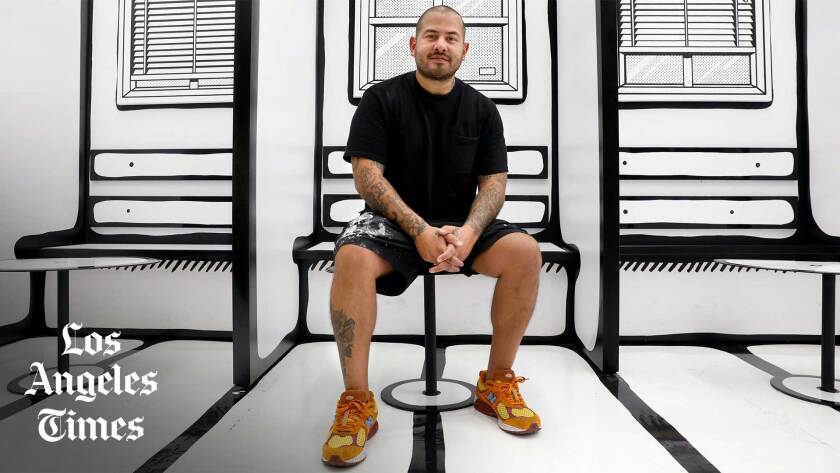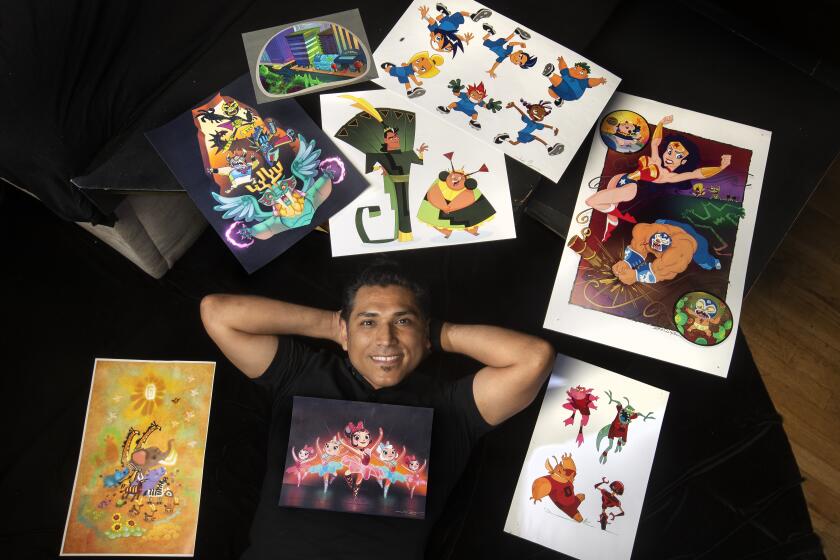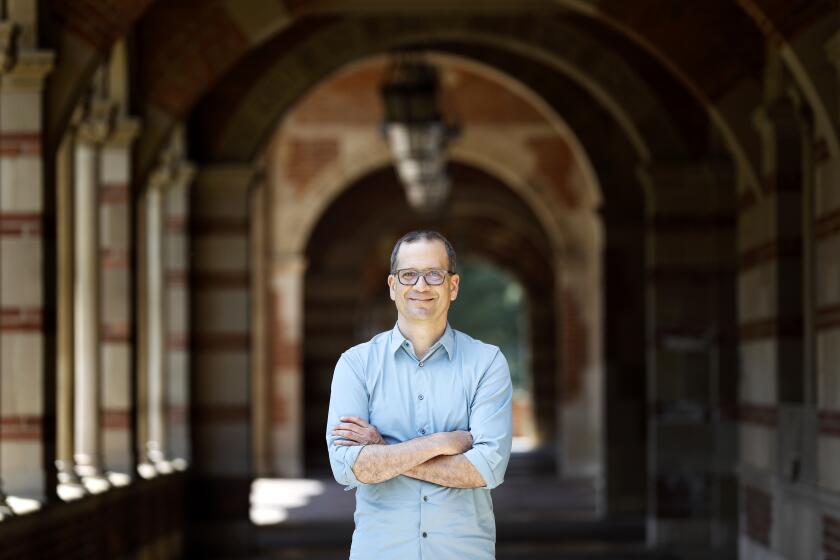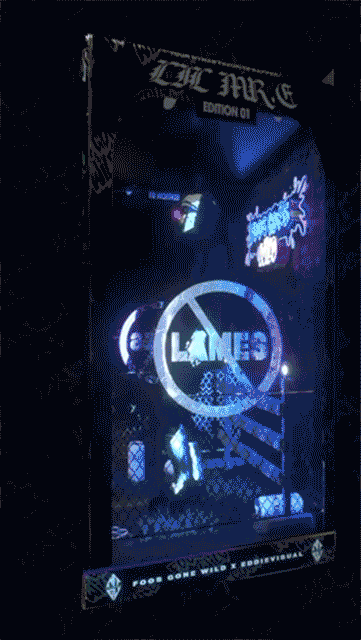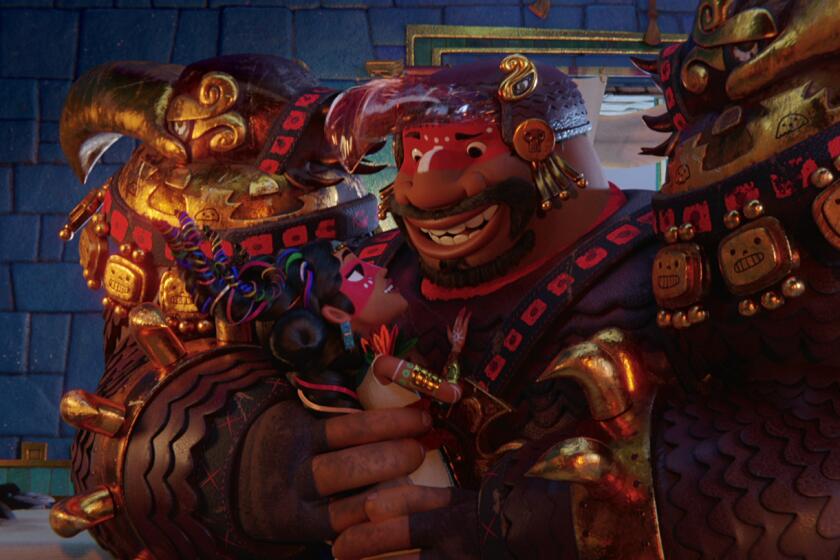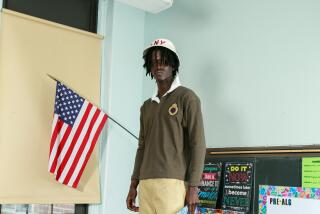A graffiti tagger as a teen, he now designs for Fendi and Mercedes-Benz
- Share via
- Share via
Strange things happen to everyday objects when Joshua Vides applies his imagination to them — something metaphysical, almost magical.
With a few deft strokes of his Sharpie pens or spritzes of spray paint, Vides blurs the line between two dimensions and three. A plain footstool jumps to life in trompe-l’oeil black and white — both a tangible artifact and an artsy abstraction. A mass-produced ‘70s-vintage Chuck Taylor sneaker mutates into a unique collectible that fetches multiple Benjamins.
Inanimate stuff — a skateboard, a traffic cone and a bottle of Scotch — suddenly emits a weird energy, as if possessed by spirits.
His creations have turned the former scofflaw graffitist into an illustrator and visual artist sought after by a growing list of global brands, including Adidas, Converse, Warner Bros., Google, Red Bull, EBay, Fendi, Ballantine’s and Mercedes-Benz. Asked how his Pop Art brushwork yields such eye-popping effects, Vides offers a deceptively unremarkable reply:
“I think it’s the simplicity of it. Some of the most beautiful things in the world are the simplest ideas.”
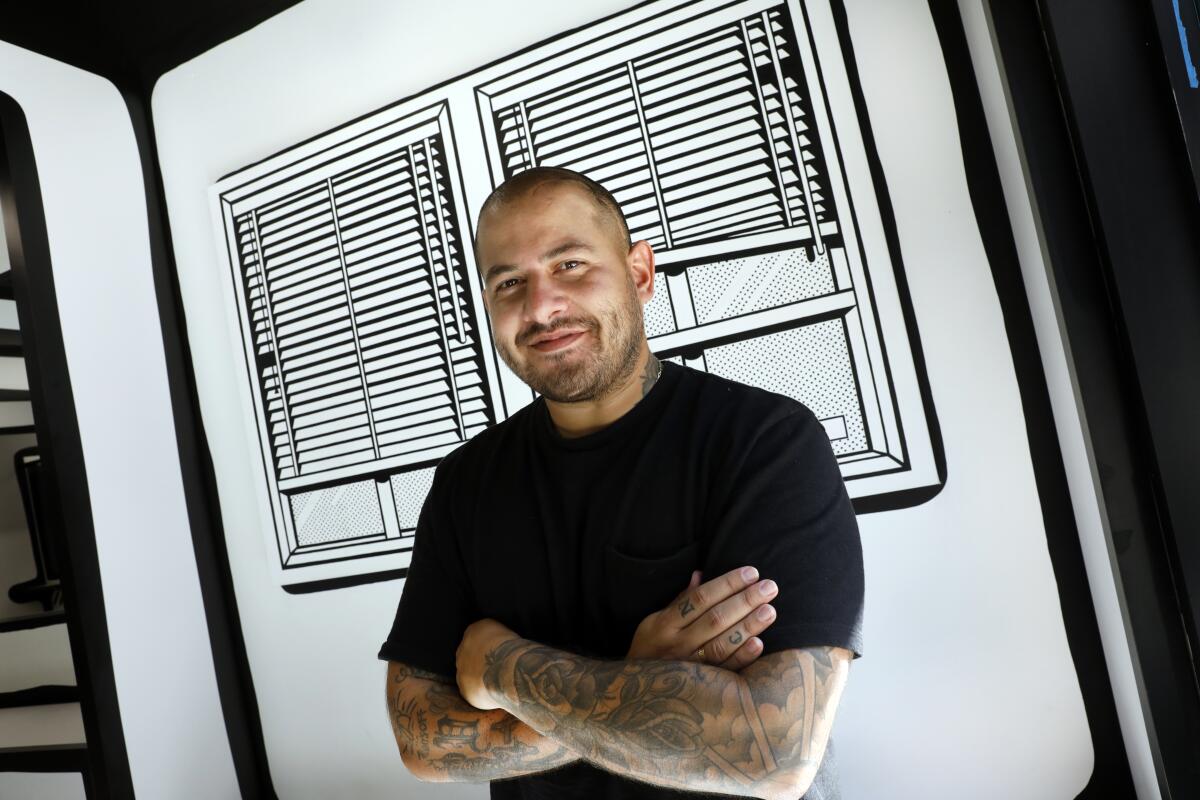
In a way, what Vides does to quotidian reality is what growing up in exurban Southern California enabled him to do: See the world anew.
The youngest of three children of Guatemalan immigrants, he was regarded by his parents and teachers as a troublesome kid, mischievous at school, with poor grades, no college prospects and a bad attitude.
“At that time my behavior did not show a bright future for me, did it?” says Vides, 31.
But the guy who dropped out of design school now appears to have a blazing future.
Jon Roy, vice president of global energy brand marketing at Converse, said his company is constantly looking for young creatives who also want to engender positive change in their communities.
“Josh is a game changer who has an uncanny knack for taking something classic, if it’s a Chuck Taylor sneaker, an Eames chair, a baseball card, or a tarp, adding a seemingly simple yet unexpected twist and creating something unique,” he says.
Yet it wasn’t so long ago that Vides felt trapped in a different kind of immersive environment, a labyrinth of depression and self-doubt. To find his way out he had to retrace his steps — back toward the simple and the beautiful.
::
The windswept city of Rialto, 50 miles east of Los Angeles, today a hub of massive distribution warehouses, was the perfect artistic backdrop for the youth with dark, alert eyes, who was introduced to skateboarding and graffiti through friends at Kolb Middle School.
During his early teens he earned money by customizing friends’ skateboards. He quickly transitioned from sketching in notebooks to tagging streets, bridges, sidewalks and traffic signs. He left his mark in squiggly letters lifted from Looney Tunes, images of men with gas masks and riffs on the Dodgers logo.
José Zelaya, the Disney Television Animation’s only Salvadoran designer and digital animator, as a boy dreamed he would “work for Mickey Mouse.”
Armed with a backpack and black-and-white spray paints, he’d sneak out of his home at night, hop on his bike and graffiti the streets of downtown Rialto.
“I would add a bat to my backpack in case I got into trouble with some other graffiti artist and I would leave,” he recalls. “Getting around the authorities and my parents was exciting.”
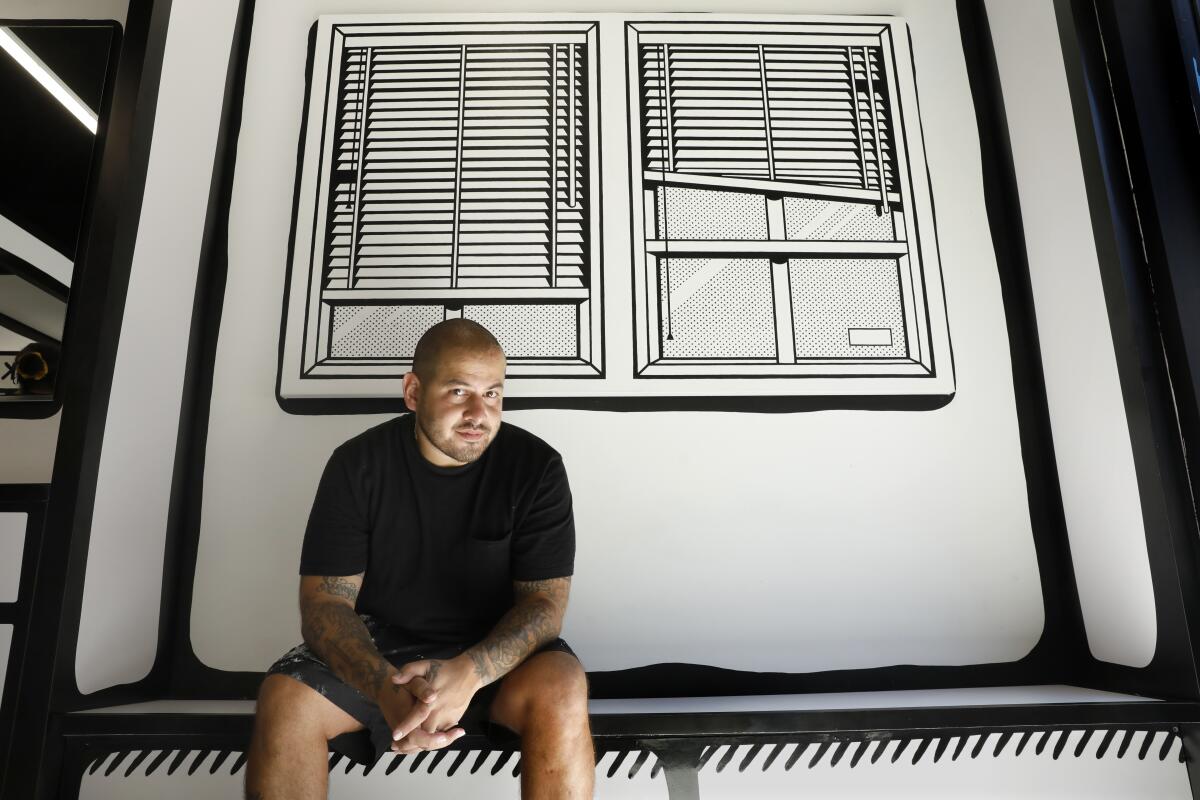
His devout evangelical parents, Oscar and Eva Vides, worked all day, leaving him and his older siblings, Carlos and Melissa, at home for long stretches under the watch of his maternal grandparents.
“My siblings were about five years older than me, but I was the only troublemaker,” Vides says.
When he was almost 15, his parents moved the family to Rancho Cucamonga to get their children away from their unwelcoming neighborhood. But their youngest son kept spreading his illicit handiwork across the Inland Empire — Pomona, Colton, Bloomington, San Bernardino.
He didn’t fear running afoul of the police, but he fretted over his still-generic style.
“That was a thorn that bothered me: My art was neither recognizable nor distinctive.”
At Los Osos High School in Rancho Cucamonga, Vides began selling stenciled shirts. After graduating he enrolled in a graphic design course at Chaffey College to learn how to screen-print. But he lost interest after a couple of months and dropped out.
L.A. Vibe Guide: Gabriela Ruiz is the buzz of the art world
Under pressure from his parents to pick a career, Vides entered a San Diego firefighter academy in February 2008. He was recruited by the Riverside County Fire Department but resigned within a year.
“I didn’t like my job,” he says. “I was bored and I thought I had a lot of creativity to be locked in a place. It was a risk I had to take.”
It was a disappointment to his parents, who had fled Guatemala’s devastating 36-year civil war.
Eva, who was 20 when she arrived stateside in 1979, found work as a supermarket cashier. Oscar, 24, arrived in 1980. He had studied to be an agronomist in Guatemala but got a foothold in his adopted country washing dishes in a restaurant.
“If I think about my ancestors, we still don’t know how they achieved and created many things. I didn’t have much school, but I had creativity and passion.”
— Joshua Vides
After marrying in 1982, the couple were able to obtain their permanent residence in 1987, thanks to the immigration reform law signed by President Reagan. Eva became a nurse, Oscar a truck driver.
Two years later, Joshua was born.
“I always knew that he was a special boy, despite being a restless and funny boy,” Eva says. “In his teens, he had bad behavior at school. He faked his father’s signature and he was suspended for painting graffiti.”
But of her son’s inventiveness and tenacity there never was any doubt.
“He continues to surprise us,” his mother says. “It has given us tremendous pride to see him grow and improve.”
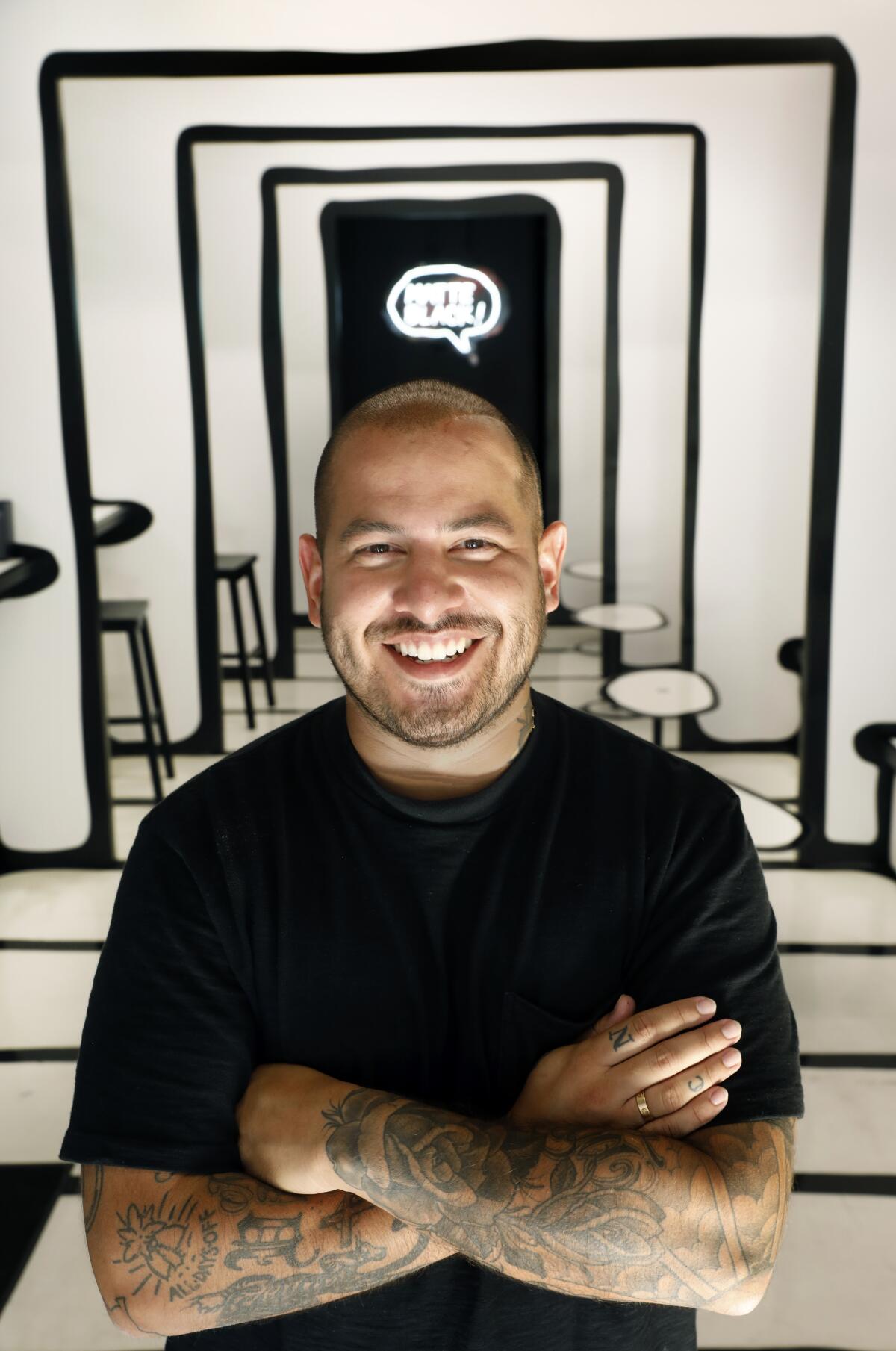
In 2009, at age 20, Vides surprised his parents once again by investing $500 to start his own shirt and insole brand, CLSC. He ran the business out of the family home in Rancho Cucamonga.
Over the next five years he held a variety of jobs as he immersed himself in the business of street fashion: assistant manager at a Zumiez clothing store, truck driver (earning $7 an hour) for the Hundreds, graphic designer and marketing manager for the Seventh Letter, a gallery.
“All those years I was learning about the market, how it worked,” he said.
Noriega, stepping down as director of UCLA’s Chicano Studies Research Center, talks about the importance of Chicano history and whether Ben Affleck should play him in the movies.
In 2014, Vides decided to dedicate himself full time to CLSC, which stands for Can’t Live Scared of Changes, and established a boutique on Fairfax Avenue in Los Angeles, selling shirts, hats, headwear and other items in his own designs. But the rise of Amazon swiftly spelled doom for his fledgling enterprise.
“Then I thought, maybe I don’t want to be behind the counter all my life. In short, I was no longer having fun,” Vides said.
By then he also was a father to a son, Cassius, born in 2013, and a daughter, Verona, born two years later. He and the children’s mother, Elle, married in April 2017, and Vides found his emotions rocking and tumbling like a roller coaster.
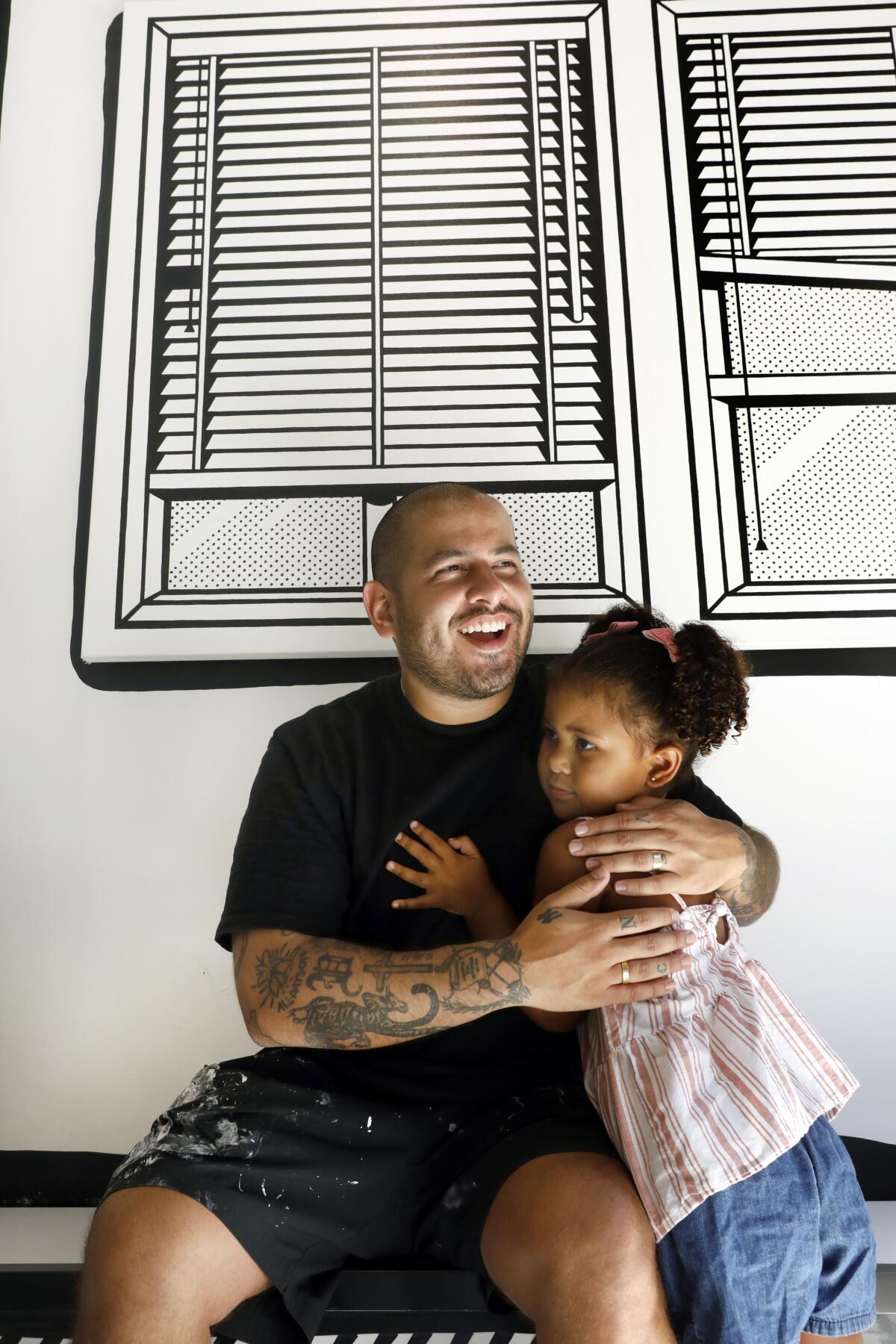
So he decided to leave his business behind. “I had to do something bigger, but I didn’t know what,” he said.
::
Being unemployed while struggling to provide for his family plunged the artist into depression. But Vides continued brainstorming. He longed for the artistic freedom he felt while tagging the streets with graffiti.
He decided to paint an object with spray paint and a Sharpie to simulate a flat, two-dimensional sketch. He picked out a pair of Reebok Classic shoes that he never wore. When he finished, his body was shaking with excitement.
“A few days later, I went out to paint a fire hydrant and I felt that drug like when I was a teenager,” he says.
Experiencing a newfound euphoria, Vides asked his wife about whether he should post his art on Instagram. The couple agreed that he should paint and post a Nike Air Force 1.
To his surprise, the work went viral on Instagram, picking up 5,000 or 10,000 followers every day, along with messages from fashion-first actors and athletes requesting the magic sneakers.
Orders for as many as 400 pairs came in per hour, he said. “But I was still broke.”
In February 2018, Vides rented a roughly 1,000-square-foot space at the corner of Melrose Avenue and Ridgewood Place to exhibit an assortment of three-dimensional objects that appeared to be black-and-white sketches. He put $8,000 of his savings into the show.
Artist Mister Cartoon and King Foo, the secretive social media impresario of Foos Gone Wild with 1.3 million Instagram followers, talk Chicano art NFTs and the future of art shows.
No wine and cheese were served. No DJ spun house music. But about 3,000 people showed up for the free event.
“I just wanted people to see my work and have that optical illusion. I was not thinking about getting paid for the entrance,” Vides says.
The response persuaded Vides to invest another $8,000 and mount a second event at the Seventh Letter in Los Angeles, just a month later. Its centerpiece was a sketched-up 1995 Acura NSX, lent to him by a friend, parked in the middle of the gallery surrounded by cones and racing flags on the walls.
Vides was exhausted, but ecstatic. And most significant of all, he had found what he longed for when tagging streets as a teenager: his own style.
In just a few days Vides was contacted by Jordan Shoes to work on a project, and the floodgate opened for commissions and requests to collaborate.
Vides has been busy ever since.
“Josh is ambitious, he likes risk, he’s good at sales and numbers and all trades,” says Ben Shenassafar, CEO of the Hundreds streetwear brand. He met Vides when he worked with the Hundreds 15 years ago, and he remembers well the hungry young man eager to prove himself. “It doesn’t surprise me to see him at the top where he is today.”
Currently, Vides’ art can be viewed through Facebook Messenger and Facebook Open Arts, a project that highlights six artists from underrepresented communities. Vides contributed to the creation of Messenger’s first black-and-white, fully immersive, 360-degree backgrounds.
“He’s interested in pushing the boundaries of where his art is shown,” says Emmett Dzieza, art director of augmented reality with Facebook Messenger.
In 2019 he and Converse worked together on ComplexCon, where he collaborated on a customizable Converse Chuck 70 sneaker that played up his unique black-and-white penmanship, but allowed for further metamorphosis via interchangeable, colored Velcro panels.
In 2020, Vides and the Museum of Contemporary Art Chicago created an exhibit that challenged him to paint the longest hallway of his career in his signature style. To accompany this piece, he worked on a 40-foot canvas that was cut and transformed into 30 pairs of one-of-a-kind Converse Chuck 70s. They were auctioned, and the proceeds benefited the museum and its mission.
Vides thinks that his gift for imparting a magical-realist sheen to whatever he touches stems from his Maya heritage, his ancestral link to the Mesoamerican civilization that stretches from Mexico’s Yucatán Peninsula into Central America.
“I don’t know how far it goes back in my family for me to be considered Mayan or Guatemalan,” Vides says, “but my parents were born there, and I can say that in the end I have Indigenous blood.”
The new Netflix series builds a temple to early Latin American civilizations that’s both endearing and dazzling.
He feels a deep affinity with that Indigenous culture of vast and mysterious works.
“If I think about my ancestors, we still don’t know how they achieved and created many things. I didn’t have much school, but I had creativity and passion.”
His parents, who had tried to steer their son toward college, have long since accepted that he found and followed another path.
“It’s only happens in the United States,” says Oscar Vides, “a country where the immigrant dream is possible if you are persistent, resourceful and hard-working.”
His son agrees — with, as usual, a twist all his own.
“I am living the American dream to some extent,” he says. “But I think I’d take out the ‘American’ and say I’m just living the ... dream in general,” he says — adding a colorful modifier.
Not everything, after all, can be expressed in black and white.
More to Read
Sign up for Essential California
The most important California stories and recommendations in your inbox every morning.
You may occasionally receive promotional content from the Los Angeles Times.
